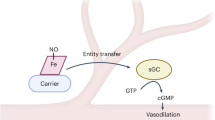Abstract
The gaseous free radical nitric oxide (NO˙) is an important regulator of a variety of biological functions and also has a role in the pathogenesis of cellular injury. It has been generally accepted that NO˙ is solely generated in biological tissues by specific nitric oxide synthases, NOSs, which metabolize arginine to citrulline with the formation of NO˙. We report that NO˙ can also be generated in the ischaemic heart by direct reduction of nitrite to NO˙ under the acidotic and highly reduced conditions that occur. This NO˙ formation is not blocked by NOS inhibitors, and with long periods of ischaemia progressing to necrosis, this mechanism of NO˙ formation predominates. We observe that enzyme-independent NO˙ generation results in myocardial injury with a loss of contractile function. The existence of this enzyme independent mechanism of NO˙ formation has important implications in our understanding of the pathogenesis and treatment of tissue injury.
This is a preview of subscription content, access via your institution
Access options
Subscribe to this journal
Receive 12 print issues and online access
$209.00 per year
only $17.42 per issue
Buy this article
- Purchase on Springer Link
- Instant access to full article PDF
Prices may be subject to local taxes which are calculated during checkout
Similar content being viewed by others
References
Moncada, S., Palmer, R.M. Jr & Higgs, E.A. Nitric oxide: Physiology, pathophysiology and pharmacology. Pharmac. Rev. 43, 109–142. 1991.
Furchgott, R.F. & Zawadzki, J.V. The obligatory role of endothelial cells on the relaxation of arterial muscle by acetylcholine. Nature 288, 373–376. 1980.
Palmer, R.M. Jr, Ferridge, A.G. & Moncada, S. Nitric oxide release accounts for the biological activity of endothelium-derived relaxing factor. Nature 327, 524–526. 1987.
Ignarro, L.J., Byrns, R.E., Buga, G.M. & Wood, K.S. Endothelium-derived relaxing factor from pulmonary artery and vein possesses pharmacologic and chemical properties. Circ. Res. 61, 866–879. 1987.
Furchgott, R.F. & Vanhoutte, P.M. Endothelium-derived relaxing and contracting factors. FASEB J. 3, 2007–2018. 1989.
Marletta, M.A., Yoon, P.S., Iyengar, R., Leaf, C.D. & Wishnok, J.S. Macrophage oxidation of L-arginine to nitrite and nitrate: Nitric oxide is an intermediate. Biochemistry 27, 8706–8711. 1988.
Bredt, D.S. et al. Cloned and expressed nitric oxide synthase structurally resembles cytochrome P-450 reductase. Nature 351, 714–718. 1991.
Bredt, D.S. & Synder, S.H. Nitric oxide: A novel neuronal messenger. Neuron 8, 3–11. 1992.
Moncada, S., Palmer, R.M. Jr & Higgs, E.A. Biosynthesis of nitric oxide from L-arginine: A pathway for the regulation of cell function and communication. Biochem. Pharmac. 38, 1709–1715. 1989.
Garthwaite, J. Glutamate, nitric oxide and cell-cell signalling in the nervous system. Trends Neurosci. 14, 60–67. 1991.
Langrehr, J.M., Hoffman, R.A., Lancaster, J.R. Jr & Simmons, R.L. Nitric oxide, a new endogenous immunomodulator. Transplantation 55, 1205–1212. 1993.
Beckman, J.S., Beckman, T.W., Chen, J., Marshall, P.A. & Freeman, B.A. Apparent hydroxyl radical production by peroxynitrite: Implications for endothelial injury from nitric oxide and superoxide. Proc. natn. Acad. Sci. U.S.A. 87, 1620–1624. 1990.
Zweier, J.L., Wang, P. & Kuppusamy, P. Direct measurement of nitric oxide generation in the ischemic heart using electron paramagnetic resonance spectroscopy. J. biol. Chem. 270, 304–307. 1995.
Lancaster, J.R. Jr et al. Detection of nitric oxide by electron paramagnetic resonance spectroscopy during rejection of rat heart allograft. J. biol. Chem. 267, 10994–10998. 1992.
Lai, C.S. & Komarov, A.M. Spin trapping of nitric oxide produced in vivo in septic-shock mice. FEBS Lett. 345, 120–124. 1994.
Shinobu, L.A., Jones, S.G. & Jones, M.M. Sodium N-methyl-D-glucamine dithiocarbamate and cadmium intoxication. Acta Pharmacol. Toxicol. 54, 189–194. 1984.
Zweier, J.L. Measurement of superoxide-derived free radicals in the reperfused heart: Evidence for a free radical mechanism of reperfusion injury. J. biol. Chem. 263, 1353–1357. 1988.
Zweier, J.L. et al. Measurement and characterization of postischemic free radical generation in the isolated perfused heart. J. biol. Chem. 264, 18890–18895. 1989.
Furfine, E.S., Harmon, M.F., Paith, J.E. & Garvey, E.P. Selective inhibition of constitutive nitric oxide synthase by L-NG-nitroarginine. Biochemistry 32, 8512–8517. 1993.
Zweier, J.L. & Jacobus, W.E. Substrate-induced alterations of high energy phosphate metabolism and contractile function in the perfused heart. J. biol. Chem. 262, 8015–8021. 1987.
Garside, C. A chemiluminescent technique for the determination of nanomolar concentrations of nitrate and nitrite in seawater. Marine Chem. 11, 159–167. 1982.
Chzhan, M., Shteynbuk, M., Kuppusamy, P. & Zweier, J.L. An optimized L-band ceramic resonator for EPR imaging of biological samples. J. Magnet. Reson. A105, 49–53. 1993.
Author information
Authors and Affiliations
Rights and permissions
About this article
Cite this article
Zweier, J., Wang, P., Samouilov, A. et al. Enzyme-independent formation of nitric oxide in biological tissues. Nat Med 1, 804–809 (1995). https://doi.org/10.1038/nm0895-804
Received:
Accepted:
Issue Date:
DOI: https://doi.org/10.1038/nm0895-804
This article is cited by
-
Dietary sodium restriction reduces blood pressure in patients with treatment resistant hypertension
BMC Nephrology (2023)
-
Quantitative aspects of nitric oxide production in the heart
Molecular Biology Reports (2022)
-
Nitric oxide signalling in kidney regulation and cardiometabolic health
Nature Reviews Nephrology (2021)
-
Nitrate-functionalized patch confers cardioprotection and improves heart repair after myocardial infarction via local nitric oxide delivery
Nature Communications (2021)
-
Nitric oxide signalling in cardiovascular health and disease
Nature Reviews Cardiology (2018)



